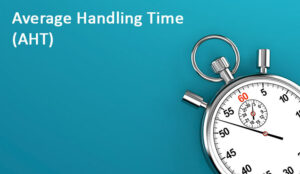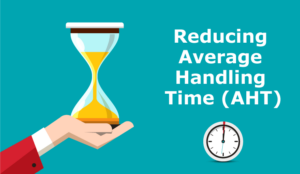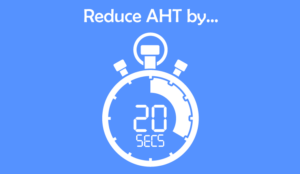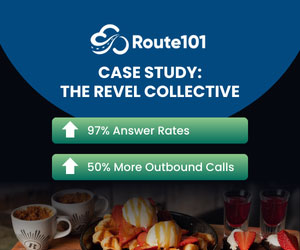Calabrio explores all things AHT, with essential best practices to reduce AHT-and shorten your conversations without compromising high-quality service.
Every conversation in a contact centre-from start to finish-holds helpful insights about the customer experience and service performance.
This is why the amount of time spent on interactions is a key metric for ensuring the efficiency of your customer service. It’s called average handle time (AHT).
What Is Average Handle Time (AHT)?
Average handle time (AHT) is the average duration of a customer interaction in a contact centre. That is, AHT measures the time an interaction takes from beginning to end. It starts from the moment a customer gets connected with an agent after waiting in a queue until the end of that interaction.
Contact Centre AHT Components:
It’s important to understand that average handle time is, in a sense, a metric of metrics. That is, contact centre handle time can be broken down into the following parts:
- Talk Time: The length of time, in seconds or minutes, an agent spends speaking or engaging with a customer during a single interaction.
- Hold Time: The length of time a customer spends on hold during the interaction.
- After-call work (ACW) or wrap-up time: The time an agent spends on required post-interaction tasks, including system updates, customer case log updates, interactions with colleagues, and any scheduling of follow-ups.
- Overall call volume: Understand your average handle times across the contact centre by looking this total number of calls.
Note, however, that handle time doesn’t count the time a customer spends waiting in the queue. For example, if a customer is waiting in line to speak with an agent for 30 minutes, that number isn’t figured into the final AHT.
How to Calculate AHT in the Call Centre
The calculation of AHT involves adding up the totals of these components – taking talk time, hold time, and the duration of post-call activities from all interaction across the contact centre – then dividing the sum by the number of customer calls.
Here’s the average handle time formula:
AHT = (Total Talk Time + Total Hold Time + Total ACW Time) / Total Number of Calls
Why is Average Handle Time So Important to Contact Centres?
Did you know that 54% of customers will stop working with a company if they have only one poor service experience?
This means that assuring quality customer service needs to be a top priority for call centres. Strategic contact centre reporting and the monitoring of important KPIs is a key part of any approach to elevating customer experiences.
And AHT itself is an important indicator of both agent performance and overall contact centre productivity.
Measuring AHT can help contact centres:
- Understand agent preparation and needs: AHT can provide evidence of how well call centre agents are equipped to handle customer questions and concerns.
- Identify areas of improvement: Monitoring changes and trends in AHT can help leaders gauge efficiency levels and identify issues in performance, processes, or training—as well as pinpoint best practices that can be more widely implemented.
- Improve staffing and capacity planning: Analysing AHT over time provides important insight into to contact centre forecasting processes and can help improve scheduling accuracy.
- Elevate customer satisfaction: Meanwhile, AHT is also a critical metric for understanding overall contact centre customer experiences. By evaluating handle times and taking action to improve them, teams can also raise customer satisfaction (CSAT) scores that often move in direct correlation with handle times.
Setting An Average Handle Time Benchmark: What is a Good AHT?
In the broadest terms, there’s no exact number that constitutes a “good” AHT. However, according to the most recent available data, the AHT industry standard or average is about 6 minutes and 3 seconds.
This stat, though, needs to come with an important caveat: AHT can vary significantly across industries and organizations, as the complexity of customer issues and the high-value nature of interactions differs from business to business, vertical to vertical.
AHT can also fluctuate significantly within single organizations. So, while this industry standard offers a good starting place for contact centres looking to benchmark their own performance, it’s important to analyse your operation’s metrics within their historical context to derive insights that guide your strategies for improvement.
How to Improve Average Handle Time (AHT) at Your Contact Centre
If your organization is striving for lower average handle times, there are thankfully a variety of strategies and solutions to help reduce and improve this key metric.
1. Capture 100% of Your Interactions with Conversation Intelligence
The combination of reliable call centre recording solutions and interaction analytics software helps you track AHT on every call, instantly flagging low-performance scores.
By incorporating solutions powered by AI, you can monitor service performance in real time with dashboards and data analysis reports, essential for managing the time you spend on calls.
What’s more, with the right set of AI-driven conversation intelligence tools, you can leverage speech analytics help identify the root causes lengthy conversations. Speech analytics can identify numerous factors that could negatively impact AHT score, including:
- Dead air
- Angry customers
- Hold-time violations
- Negative or neutral customer sentiment
2. Monitor and Improve Other Performance Metrics
Part of lowering your average handle time is capturing 100% of customer interactions and analysing other metrics as well. There are other customer experience metrics, known as key performance indicators (KPIs), that offer deeper insight into customer interactions, including:
First Contact Resolution Rate (FCR)
This critical customer service metric measures the number of customer connections that were resolved within the first interaction.
It’s tied to contacts on the organization’s side, and regardless of the number of callbacks or chat backs, each integration gets its own AHT assigned. A good FCR rate ranges from 70 to 75%.
Net Promoter Score (NPS)
A net promoter score (NPS) is used to score how likely your customers are willing to recommend your company’s products or services.
For example, a caller may be asked “On a scale of one to ten, how likely are you to recommend to a friend?” This number can also improve customer satisfaction scores.
Customer Satisfaction (CSAT)
This metric is closely tied to customer experience since a happy customer likely had a good experience. CSAT is usually a one-word question on a follow-up survey to ask about the satisfaction with that interaction. Companies use this number to track progress and pinpoint trouble areas.
Customer Effort Score (CES)
This score is usually acquired through a survey where a scale of one to ten indicates how much effort customers need to put in to get their problems resolved.
If they had a quick and efficient chat, they may rate it a 1 or 2; on the other hand, if multiple phone calls and agents were involved, that number can jump to 8 or 9.
3. Learn From Customer Sentiment
One of the best practices to reduce average handle time is to learn from successful cases of customer query resolution, high satisfaction scores, and positive sentiment.
4. Automate Repetitive and Time-Consuming Tasks
There are repetitive and demanding tasks related to calls that take time for your staff to complete: call logging, data entry, interaction reviewing, and more. Map these activities in your workflow and equip your team with the best automated tools to reduce AHT.
For example, you can leverage AI to score your calls based on relevant metrics such as resolution rate or AHT. That means you can pick and choose where to manually review calls, saving you time.
5. Provide Continuous Feedback
Do your agents struggle with adherence to scripts, have knowledge gaps, or even communication issues? All these challenges contribute to an increase in your AHT. The first step is to identify what is lacking in team coaching.
AI-powered contact centre software classifies interactions, quickly showing top and bottom agent performers based on customer sentiment, resolution, and QA scores.
Increase CSAT with Better AHT – And The Right Tools
Customers expect fast, reliable, and personal experiences from call centres. To help mitigate low net promoter scores and resolve customer issues, it’s vital to assess the average handle times of every agent and call centre.
Using machine learning and AI to shed light on customer sentiment can greatly improve the whole process with deeper insights provided in real time.
Calculating the AHT of your agents and organization is the springboard for developing a deeper internal knowledge base, planning programs to train agents, reducing average hold time, and improving the overall experience of every caller.
This blog post has been re-published by kind permission of Calabrio – View the Original Article
For more information about Calabrio - visit the Calabrio Website
Call Centre Helper is not responsible for the content of these guest blog posts. The opinions expressed in this article are those of the author, and do not necessarily reflect those of Call Centre Helper.
Author: Calabrio
Reviewed by: Jo Robinson
Published On: 29th May 2025
Read more about - Guest Blogs, Calabrio





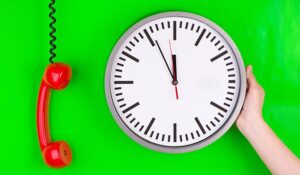
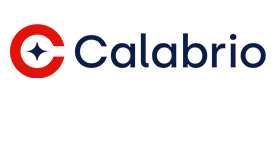 The digital foundation of a customer-centric contact centre, the Calabrio ONE workforce performance suite helps enrich and understand human interactions, empowering contact centres as a brand guardian. Calabrio ONE unites workforce optimisation (WFO), agent engagement, and business intelligence solutions into a cloud-native, fully integrated suite.
The digital foundation of a customer-centric contact centre, the Calabrio ONE workforce performance suite helps enrich and understand human interactions, empowering contact centres as a brand guardian. Calabrio ONE unites workforce optimisation (WFO), agent engagement, and business intelligence solutions into a cloud-native, fully integrated suite. 
